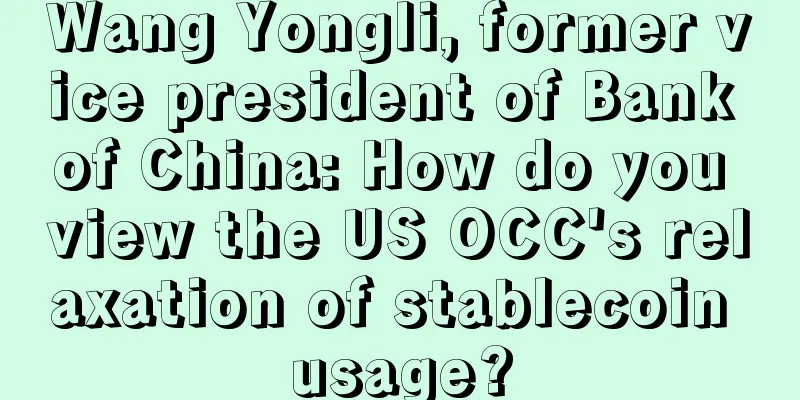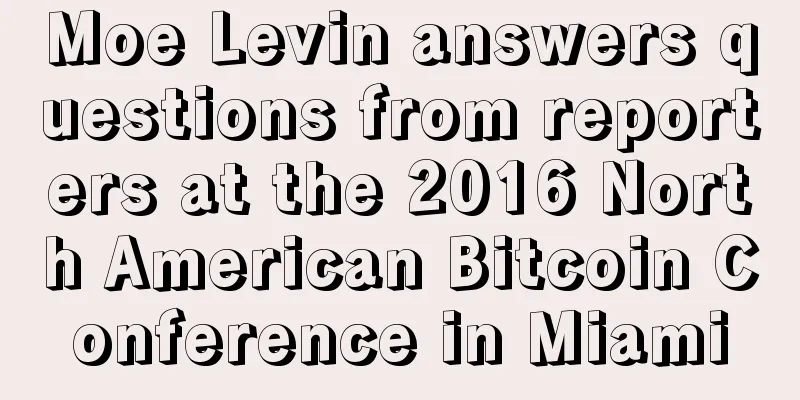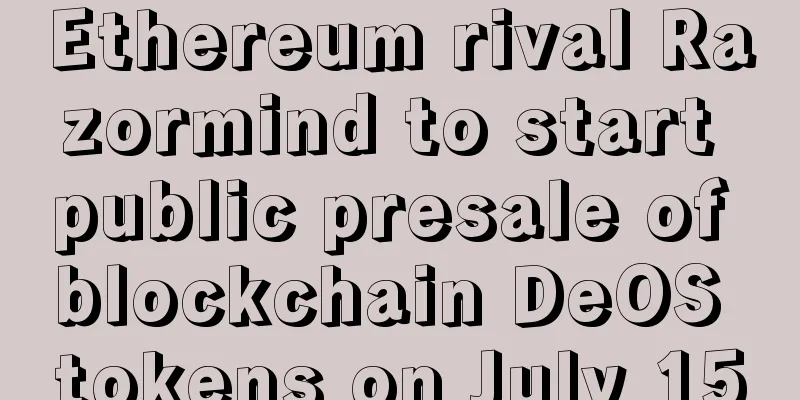Wang Yongli, former vice president of Bank of China: How do you view the US OCC's relaxation of stablecoin usage?

Original title: "Wang Yongli | How to view the US OCC's relaxation of stablecoin use" Original source: Wang Yongli On January 4, the U.S. Office of the Comptroller of the Currency (OCC) issued an explanatory letter stating that U.S. national banks and federal savings associations can become operating nodes of blockchain stablecoins and use the associated stablecoins for "permitted payment activities." It believes that the blockchain stablecoin network can be used as a "cheaper, faster, and more efficient" payment method to reduce the cost of cross-border transactions. Therefore, banks are authorized to use blockchain and its stablecoins to convert back and forth with legal tender during remittances. If banks choose, they can also issue stablecoins themselves (for example, JPMorgan Chase Bank has proposed to launch its own U.S. dollar stablecoin JPMcoin, etc.). Some people believe that this is a huge victory for the crypto industry and public chains. Banks can view public chains as financial infrastructure similar to SWIFT and Fedwire, and stablecoins (such as USDC) as new electronic stored value. It will help the United States take the lead in embracing public chains and stablecoins, promote dollar-based digital stablecoins to become the mainstream medium for payment and settlement, and further enhance the influence of the dollar worldwide. 2021 will be a key year for public chains and stablecoins to enter the mass market. The door to a new era is quietly opening, and the game has begun. So, how should we view this move by the OCC?First of all, the stablecoins referred to in this statement by the OCC are not any stablecoins, but stablecoins that have been reviewed and approved by the regulatory authorities and are subject to their continuous supervision. At present, such stablecoins mainly include USDC, GUSD, PAX, etc. Stablecoins that have not been reviewed and approved by the regulatory authorities, such as USDT, have not been reviewed and approved by the regulatory authorities, although they have been in actual operation for a long time and currently have a great market influence, but have not yet passed the review of the regulatory authorities, so they are not included in this scope. More importantly, the stablecoins referred to by the OCC refer to stablecoins that are simply pegged to the equivalent of the US dollar (in fact, the "network token" of the US dollar), not stablecoins pegged to the equivalent of other countries' currencies, nor are they super-sovereign stablecoins that are structurally linked to a basket of currencies including the US dollar (although the US dollar may have the largest currency basket coefficient, it is still different from the US dollar). At the same time, this does not include virtual cryptocurrencies that are completely endogenous to the network (need to be "mined"), such as Bitcoin, Ethereum, etc., because this has any connection with the US dollar and will not boost the international status of the US dollar. Therefore, the public blockchain mentioned by the OCC is not a decentralized, permissionless open source blockchain like Bitcoin and Ethereum, but a permissioned blockchain that requires participants to comply with all legal regulations, including applicable user real-name, anti-money laundering, anti-terrorist transmission and consumer protection laws and regulations. This statement by the OCC does not represent a victory for permissionless public chains. Secondly, this move by the OCC reflects the support of the US regulatory authorities for supporting blockchain and stablecoin innovation and exploration, actively striving to seize the leading position in blockchain and stablecoin payment and settlement, and enhancing the international influence of the US dollar. At the same time, it also shows that it must include stablecoins in strict supervision. Innovation in monetary finance must be carried out under the premise of macro-prudential supervision and compliance with the law.Again, this move by the OCC is not a problem in the United States, but if the US dollar stablecoin is to be promoted for cross-border payment and settlement, it is actually necessary for the international community to reach a consensus and form international rules that are commonly followed. Otherwise, even if the US allows the free exchange of US dollars and stablecoins, it does not mean that other countries also allow such stablecoins to be freely exchanged with their own currencies, which is bound to cause many problems. At the same time, the United States can launch a US dollar stablecoin operating system, and other countries can also launch different operating systems such as euro stablecoins, RMB stablecoins, and Japanese yen stablecoins, which may form a situation of mutual competition. In the end, the international influence of different currency stablecoins still depends on the comprehensive national strength and international influence of the country that issues such currency. Of course, it will also be affected by the efficiency and security of different stablecoin operating systems. From the perspective of maximizing the overall interests of the world, the coexistence of multiple cross-border payment and clearing systems will inevitably lead to huge investment and system operation and maintenance costs, which is not a reasonable choice. This cross-border payment and clearing system is actually a kind of financial infrastructure. In terms of system operation and management rules, the more centralized and unified the better. An important revelation to note:Currency and its form and operation need to be understood separately.With the emergence and continuous development of Bitcoin, the concept of "digital currency" has continued to heat up. Decentralized digital cryptocurrencies endogenous to the network, network stablecoins pegged to a single legal currency, supranational network stablecoins structurally linked to a basket of legal currencies, and central bank digital currencies that are digitized from legal currencies have continued to emerge, triggering very heated debates around the world on the nature of currency, the origin of currency, the function of currency, the expression and operation of currency, monetary policy and currency control, etc. But in fact, these debates largely blur the distinction between currency and its form and operation, and confuse the two. In fact, money is created and developed to meet the needs of social wealth exchange transactions, and plays the core functions of value scale and exchange medium. Its development has gone through the stages of natural physical currency (the most popular items among social groups, such as special shells, bones, feathers, etc.), regulated metal currency (gold coins, copper coins, silver coins, etc. manufactured according to certain regulations), metal standard paper money (metal currency daily circulation tokens), and pure credit currency separated from physical objects. Now, the currencies of all countries in the world have entered the credit currency stage, achieving a historic leap from physical currency to credit currency. So, why must currency be transformed from physical currency to credit currency, and whose credit is the "credit" of credit currency? This is because, with the development of the economy and society, people realize that money is becoming more and more important, but serious problems often arise due to excessive money supply or insufficient money supply. How to maintain the basic stability of the currency value and give full play to the role of money as a measure of value and medium of exchange has become an important economic and social issue that must be resolved. Through the practice of paper money circulation under the metal standard, people gradually discovered that money does not have to be a special physical object in society. It can be a pure value unit or value symbol. In theory, to maintain the basic stability of the currency value, it is necessary to ensure that the total amount of a country's currency can correspond to the total scale of tradable wealth within the country's sovereignty and protected by law, and change with the changes in the scale of social wealth, and have adjustability. Therefore, natural objects such as gold and silver that have served as currency must withdraw from the currency stage and return to their origin of social wealth. Their value also needs to be marked with new currency (price). Currency must be separated from social wealth and become a pure representation and counterpart of wealth value. Currency itself may no longer have physical value, but it can be accepted by society because the total amount of currency is based on the value of all tradable wealth in a country, is protected by national sovereignty and law, and is supported by national credit. Therefore, this non-physical currency is called credit currency, also known as sovereign currency or legal tender. Therefore, if a currency does not have the corresponding wealth of sovereignty and legal protection, its currency value stability is difficult to guarantee, and it is difficult to become a real credit currency. In the case that national sovereignty still exists and the world has not yet achieved integrated governance, it is a monetary regression to use gold or any other physical object as currency again, or to create a decentralized cryptocurrency with a strictly locked total amount and phased supply based on the principle of gold, which is impossible to succeed. However, even for credit money, with the development of science and technology, its manifestation and operation mode are constantly changing, from cash money (the manifestation form includes physical banknotes and coins, and the operation mode is direct cash payment and receipt), deposit money (the manifestation form is bank deposits, and the operation mode is cash deposit and withdrawal through deposit certificates or bank paper transfer and settlement), electronic money (the manifestation form is payment institution deposits, and the operation mode is electronic carriers and information accounting and settlement), digital money (the manifestation form is more digital, and the operation mode is more networked and intelligent), etc. It can be seen that the essence of money will not change, but its manifestation form and operation mode can remain unchanged, so as to promote its continuous improvement of operating efficiency, reduce operating costs, strictly comply with compliance and risk control, and maintain monetary and financial stability. Based on the above judgment, it can be clearly seen that:Bitcoin and other network-native encrypted digital currencies violate the logic of currency development and cannot become real circulating currencies. Instead, they can only become a new type of asset (virtual asset) that can be invested and speculated, but their prices may fluctuate violently and the risks are very high. A supranational stablecoin that is structurally linked to a basket of legal currencies sounds great, but it is difficult to implement in the absence of integrated governance in the world, and is basically a fantasy. A network stablecoin that is pegged to a single legal currency is actually a new type of token. As long as it meets regulatory requirements, it is completely possible to exist. However, it cannot subvert or replace legal currency, but can only change the form and operation of currency. The digitalization of legal tender cashlessness is still an inevitable trend, but its implementation path may have different choices of centralized and decentralized. In fact, under the unified supervision of the central bank and regulatory authorities, the network stablecoin independently promoted by different social organizations and pegged to the equivalent of a single legal tender is a manifestation of the decentralized model of legal tender digitalization. Judging from the OCC's statement, the United States may give priority to the decentralized model and may promote the international application of its digital currency through its global network of global business organizations. Another is to directly lead the central bank to launch the central bank's digital currency operating system. For example, the People's Bank of China uniformly promotes the development and operation of the digital RMB, which is a manifestation of the centralized model of legal tender digitalization. The centralized model may reduce social duplication and concentrate efforts to improve the efficiency of development and promotion. Of course, the digitalization of legal currency is easy to achieve domestically, but to apply the digital currency operating system to cross-border payment and settlement, it requires coordination and cooperation among countries and international organizations. It is not wishful thinking, even for the US dollar digital stablecoin. |
<<: If Kanye West and Kardashian divorce, how will their Bitcoin be divided?
Recommend
Career line starts from life line
The career line starts from the life line. The ca...
What kind of woman is the most attractive?
Some people's attractiveness is limited to th...
Palmistry marriage line to see a person's marital status
1. A marriage line In palmistry, if a person has ...
Career and destiny through face reading
Career and destiny through face reading {Eyes are...
Which part of your face attracts attention?
Which part of your face attracts attention? Or ev...
The face of a person who can write poems and fu in his spare time
Sometimes, when people have free time, they have ...
A complete analysis of women's cheekbones
Women with low cheekbones are gentle, while women ...
The OTC market may reflect the real demand for Bitcoin, with the largest transaction valued at $50 million
How will the world's financial elite diversif...
These people have rich faces but still dress simply and have a good nose bridge
Many people always dress themselves in famous bra...
Detailed analysis of the zodiac signs
Detailed analysis of the zodiac signs In addition...
What does a woman with a mole on the right corner of her mouth look like? What does a mole on the right corner of the mouth mean?
People with moles at the corners of their mouths ...
How will your love end from your palm
The key to love is management. Today, look at you...
See the fortune of children through palmistry
See the fortune of children through palmistry Sta...
Looking at the data, who is really driving Bitcoin's recent big rebound?
Is it retail investors? High net worth individual...
Moles on women's foreheads - illustration and analysis of moles
Moles are very common, and everyone has them more...









